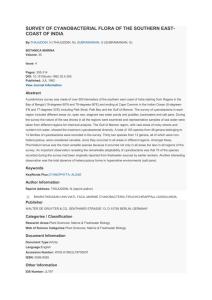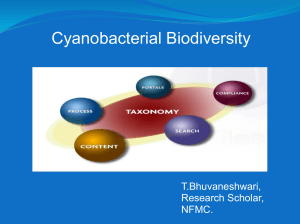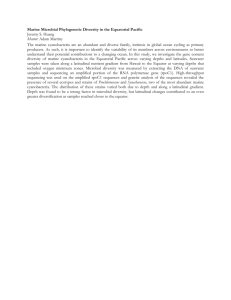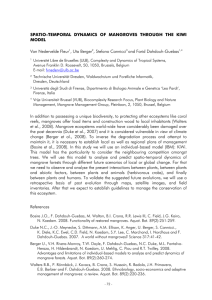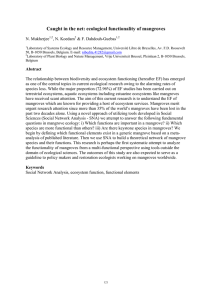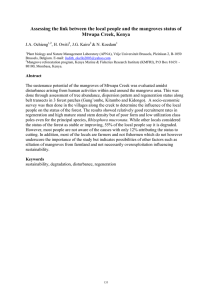Current Research Journal of Biological Sciences 4(3): 235-238, 2012 ISSN: 2041-0778
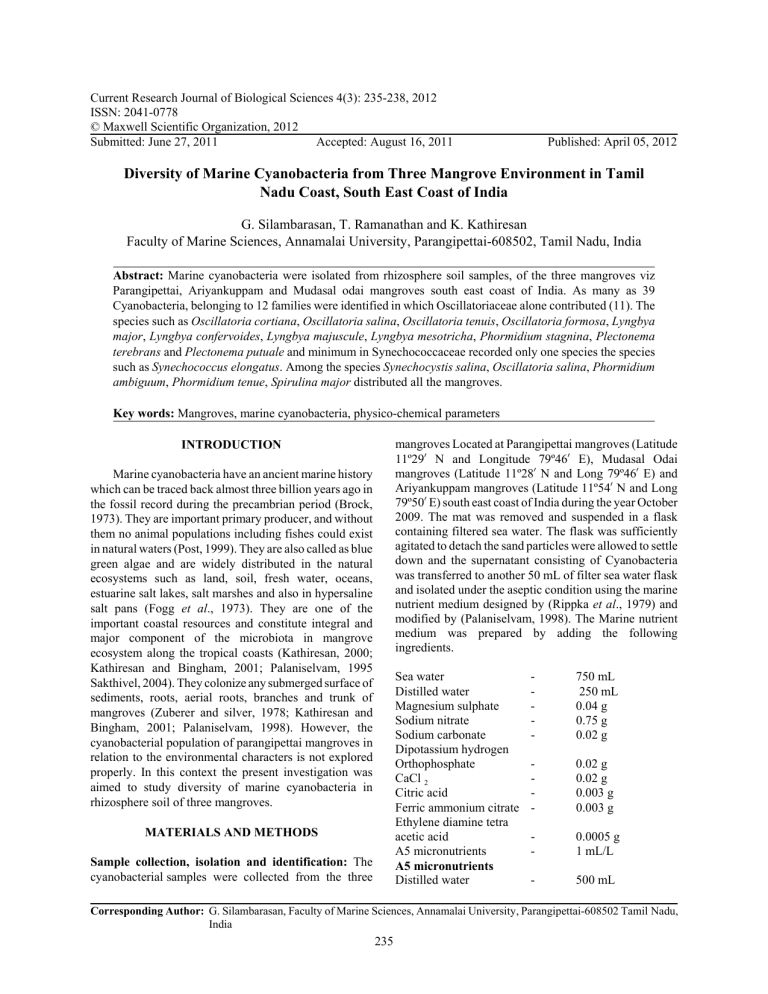
Current Research Journal of Biological Sciences 4(3): 235-238, 2012
ISSN: 2041-0778
© Maxwell Scientific Organization, 2012
Submitted: June 27, 2011 Accepted: August 16, 2011 Published: April 05, 2012
Diversity of Marine Cyanobacteria from Three Mangrove Environment in Tamil
Nadu Coast, South East Coast of India
G. Silambarasan, T. Ramanathan and K. Kathiresan
Faculty of Marine Sciences, Annamalai University, Parangipettai-608502, Tamil Nadu, India
Abstract: Marine cyanobacteria were isolated from rhizosphere soil samples, of the three mangroves viz
Parangipettai, Ariyankuppam and Mudasal odai mangroves south east coast of India. As many as 39
Cyanobacteria, belonging to 12 families were identified in which Oscillatoriaceae alone contributed (11). The species such as Oscillatoria cortiana , Oscillatoria salina , Oscillatoria tenuis , Oscillatoria formosa , Lyngbya major , Lyngbya confervoides , Lyngbya majuscule , Lyngbya mesotricha , Phormidium stagnina , Plectonema terebrans and Plectonema putuale and minimum in Synechococcaceae recorded only one species the species such as Synechococcus elongatus . Among the species Synechocystis salina , Oscillatoria salina , Phormidium ambiguum , Phormidium tenue , Spirulina major distributed all the mangroves.
Key words: Mangroves, marine cyanobacteria, physico-chemical parameters
INTRODUCTION
Marine cyanobacteria have an ancient marine history which can be traced back almost three billion years ago in the fossil record during the precambrian period (Brock,
1973). They are important primary producer, and without them no animal populations including fishes could exist in natural waters (Post, 1999). They are also called as blue green algae and are widely distributed in the natural ecosystems such as land, soil, fresh water, oceans, estuarine salt lakes, salt marshes and also in hypersaline salt pans (Fogg et al ., 1973). They are one of the important coastal resources and constitute integral and major component of the microbiota in mangrove ecosystem along the tropical coasts (Kathiresan, 2000;
Kathiresan and Bingham, 2001; Palaniselvam, 1995
Sakthivel, 2004). They colonize any submerged surface of sediments, roots, aerial roots, branches and trunk of mangroves (Zuberer and silver, 1978; Kathiresan and
Bingham, 2001; Palaniselvam, 1998). However, the cyanobacterial population of parangipettai mangroves in relation to the environmental characters is not explored properly. In this context the present investigation was aimed to study diversity of marine cyanobacteria in rhizosphere soil of three mangroves.
MATERIALS AND METHODS
Sample collection, isolation and identification: The cyanobacterial samples were collected from the three mangroves Located at Parangipettai mangroves (Latitude
11º29
!
N and Longitude 79º46
!
E), Mudasal Odai mangroves (Latitude 11º28
!
N and Long 79º46
!
E) and
Ariyankuppam mangroves (Latitude 11º54
79º50
!
N and Long
!
E) south east coast of India during the year October
2009. The mat was removed and suspended in a flask containing filtered sea water. The flask was sufficiently agitated to detach the sand particles were allowed to settle down and the supernatant consisting of Cyanobacteria was transferred to another 50 mL of filter sea water flask and isolated under the aseptic condition using the marine nutrient medium designed by (Rippka et al ., 1979) and modified by (Palaniselvam, 1998). The Marine nutrient medium was prepared by adding the following ingredients.
Sea water
Distilled water
Magnesium sulphate
Sodium nitrate
Sodium carbonate
Dipotassium hydrogen
Orthophosphate
CaCl
2
Citric acid -
Ferric ammonium citrate -
-
-
-
-
-
Ethylene diamine tetra acetic acid
A5 micronutrients
A5 micronutrients
Distilled water
-
-
-
750 mL
250 mL
0.04 g
0.75 g
0.02 g
0.003 g
0.003 g
0.0005 g
1 mL/L
500 mL
Corresponding Author: G. Silambarasan, Faculty of Marine Sciences, Annamalai University, Parangipettai-608502 Tamil Nadu,
India
235
Boric acid
Manganous chloride
Zinc sulphate
Sodium molybdate
Copper sulphate
-
-
-
-
-
Curr. Res. J. Biol. Sci., 4(3): 235-238, 2012
1.43 g
0.95 g
0.111 g
0.0086 g
0.0395 g parangipettai, ariyankuppam and mudasal odai mangroves
Parameters
Temperature
Salinity (ppt) pH
Parangipettai
32.5
31.5
8.10
Ariyankuppam
31.5
30.5
7.1
Mudasal odai
33.52
34.45
08.20
The cyanobacterial sample was collected and diluted using sterile water to 10
G
3 , 10
G
5 , and 10
G
5 , respectively.
(0.1 mL) of the diluent was inoculated using pore plate method. The culture was incubated at 25±2ºC under continue illumination (3,000 lux). Cyanobacterial species were identified using the standard references
(Desikachary, 1959; Humm and Wicks, 1980). All the study was conducted in our Laboratory, Faculty of Marine
Sciences, Annamalai University.
Analysis of physicochemical variables: Temperature was measured by mercury thermometer 0.5ºC accuracy.
The pH was measured by using a calibrated pH pen
(Phep, Hanna instruments Mauritius Ltd., Portugal) with an accuracy of ±0.1. The salinity was measured by using a hand refractometer (Atago hand refractometer, Japan).
The physicochemical parameters of samples were analyzed using the standard methods (Strickland and
Parson, 1972).
RESULTS AND DISCUSSION
The detailed of the environmental parameters prevailing in different mangrove waters is depicted in the
Table 1. The temperature was maximum with Mudasal odai mangroves (33.52) in and minimum in
Ariyankuppam mangroves (31.5). The pH was maximum in mudasal odai mangroves (8.20) and minimum in
Ariyankuppam mangroves (7.1). The salinity was maximum in (34.45) and minimum in Ariyankuppam mangroves (30.5). Marine cyanobacteria constitute integral and major component of the micro biota in every mangrove system (Potts, 1979, 1980; Hussain and Khoja,
1993; Kathiresan and Bingham, 2001; Palaniselvam and
Kathiresan, 2002; Sakthivel, 2004). Despite this seeming metabolic uniformity, their ecological diversity is remarkable; they occupy a very wide range of illuminated ecological niches in terrestrial, marine, and freshwater environments. Most marine forms grow along the shore as benthic vegetation in the zone between the high and low tide marks (Humm and Wicks, 1980; Ramachandran,
1982; Thajuddin, 1991b; Palaniselvam, 1995, 1998;
Ramachandra Rao, 1994; Thajuddin and Subramanian,
2002; Kathiresan and Bingham, 2001). However, the cyanobacteria of Parangipettai, Ariyankuppam and
Mudasal odai are not explored properly. The present chapter evaluates how the environment parameters of cyanobacteria. An attempt has also been made to delineate the subtle relationship between cyanobacteria and the environmental conditions within the mangrove ecosystem of Parangipettai, Ariyankuppam and Mudasal odai mangroves.
Non-heterocystous forms dominate in the saline environment and this finding is in accordance with many other workers (Thajuddin and Subaramanian, 1992;
Palaniselvam, 1998). Desikachary (1959) suggested that probably 20% of all known cyanobacteria occur in saline conditions and a majority of them are truly marine
(Thajuddin and Subramanian, 2002; Thajuddin and
Subramanian, 1991a; Nagarkar et al ., 2000). However, it is difficult to strictly segregate most of the cyanobacteria into marine and freshwater species as can be done with other algal forms (Subramanian and Thajuddin, 1995).
Thajuddin and Subramanian (1992) observed that 75 of the species recorded from the southern east coast of India have originally been reported from freshwater sources by earlier workers (Biswas, 1949; Smith, 1950; Desikachary,
1959; Tilden, 1968; Humm and Wicks, 1980).
In three mangrove areas 39 species have been recorded in the present study (Table 2), which belongs to
12 families. Among the families maximum was recorded in Oscillatoriaceae (11). The species such as Oscillatoria cortiana, Oscillatoria salina, Oscillatoria tenuis,
Oscillatoria formosa, Lyngbya major, Lyngbya confervoides, Lyngbya majuscule, Lyngbya mesotricha ,
Phormidium stagnina, Plectonema terebrans and
Plectonema putuale and minimum in Synechococcaceae recorded only one species the species such as
Synechococcus elongatus. Among the species
Synechocystis salina, Oscillatoria salina , Phormidium ambiguum , Phormidium tenue, Spirulina major distributed all the mangrove areas.
SUMMARY AND CONCLUSION
Biotic and abiotic factors influence the distribution of cyanobacteria in marine environment. Basic knowledge of ecological factors is important for understanding the ecology and biodiversity of cyanobacteria. Bearing this in mind, marine cyanobaceria were studied from soil samples, of the south east coast of India. As many as 39
Cyanobacteria, belonging to 12 families were identified in which Oscillatoriaceae alone contributed (11) species and minimum in Synechococcaceae contributed only one species the species such as Synechococcus elongatus .
236
Curr. Res. J. Biol. Sci., 4(3): 235-238, 2012
Table 2: Diversity of marine cyanobacteria in three mangroves viz parangipettai, ariyankuppam and mudasal odai of south east coast of India
Name of the species cyanobacteria
Name of mangroves
------------------------------------------------------------------------------------------------------
Parangipettai Ariyankuppam Mudasal odai
Chroococcaceae
Chroococcus tenax (Kirchner) Hieron.
Chroococcus varius A. Br.
Chroococcus turgidus (Kutzing) Nag
Dermocarpaceae
Dermocarpa leibleinea(Reinsch)Born.etThur.
+
Merismopediaceae
Aphanocapsa littoralis Hansgirg +
Merismopedia aeruginea Breb.
!
+ Synechocystis salina Wislough
Microcystaceae
Gloecapsa aeruginosa (Carm.) Kutz.
Microcystis litoralis (Hansg)Forti
Microcystis aeruginosa Kutz
Nostocaceae
Anabaena torulosa Lagerh. ex Born et Flah.
Anbaena variabilis Kutz. var. ellipsospora Fritsch
Anabaena spharica Bornet et Flah.ault
+
+
+
!
!
+
+
+
!
Anabaena iyengarri Bharadwaja
Oscillatoriaceae
+
Oscillatoria cortiana Meneghini ex Gomont +
Oscillatoria salina Biswas +
Oscillatoria tenuis Ag. Ex Gomont
Oscillatoria formosa Bory ex Gomont
Lyngbya major
Lyngbya confervoides C.Ag.ex Gomont
+
+
+
+
Lyngbya majuscule Harvey ex Gomont
Lyngbya mesotricha Skuja
Phormidium stagnina
Plectonema terebrans Bornet er Gomont
Plectonema putuale (Kirchner) Hansgirg
+
+
!
+
!
Phormidiaceae
Phormidium ambiguum Gomont
Phormidium tenue (Menegh.) Gomont
Phormidium fragile (Menegh.) Gomont.
Phormidium valderianum (Delp.) Gomont
Trichodesmium erythraeum Ehrenberg ex Gomont
Pseudanabaenaceae
Spirulina subsalsa Oerst.ex Gomont
Spirulina major Kutz.ex Gomant
Rivulariaceae
Calothrix brevissima
Calothrix bharadwajae
Dichothrix bauriana (Grun.) Born.et Flash.
Scytonemataceae
Scytonema chiastum
Scytonema varium
Synechococcaceae
Synechococcus elongatus Nag
Xenococcaceae
Myxosarcina concinna Printz
+: Present; -: Absent
+
!
+
+
+
+
+
+
+
!
+
+
+
!
!
!
+
!
!
!
+
+
!
!
+
!
+
!
+
+
+
!
!
+
!
!
+
!
!
+
!
+
+
!
+
+
!
!
!
+
!
+
+
!
+
!
!
+ +
+
+
!
!
+
+
!
!
+
+
!
+
+
!
!
+
!
+
!
!
!
+
!
+
!
+
+
+
+
!
!
!
!
However, the cyanobacteria of Parangipettai,
Ariyankuppam and mudasal odai Mudasal Odai mangroves are not explored properly. An attempt has also been made to cyanobacterial diversity.
REFERENCES
ACKNOWLEDGMENT
The authors are thankful to Prof. T. Balasubramanian,
Dean, Faculty of Marine Sciences, Annamalai University for providing facilities.
Biswas, K., 1949. Common Fresh Water and Brackish
Water Algal Flora of India and Burma (Part I&II).
Records of the Botanical Survey of India, Manager of
Publications, New Delhi.
Brock, T.D., 1973. Evalutionary and Ecological Aspects of the Cyanophytes, In: Carr, N.G. and B.A. Whitton,
(Eds.), The Biology of Blue-Green Algae. Blackwell
Scientific Publications, Oxford, 9: 487-500.
237
Curr. Res. J. Biol. Sci., 4(3): 235-238, 2012
Desikachary, T.V., 1959. Cyanophyta . Indian Council of
Agricultural Research, New Delhi, pp: 686.
Fogg, G.E., W.D.P. Stewart, P. Fay and E. Walsby, 1973.
The Blue Green Algae. Academic Press, London,
New York, pp: 469.
Humm, J. and R. Wicks, 1980. Introduction and Guide to the Marine Blue-Green Algae. A. Wiley Interscience
Publication, New York, pp: 1-273.
Hussain, M.I. and T.M. Khoja, 1993. Intertidal and subtidal blue green algae, algal mats of open and mangrove areas in the Farasah Archipelago (Saudi
Arabian) Red Sea. Bot. Mar., 36: 377-388.
Kathiresan, K. and B.L. Bingham, 2001. Biology of mangroves and mangrove ecosystems. Adv. Mar.
Biol., 40: 81-251.
Kathiresan, K., 2000. Mangrove Atlas and Status of
Species in India. A report submitted to Ministry of
Environment & Forests, Govt. of India, New Delhi, pp: 235.
Nagarkar, S., G. Subramanian and N. Thajuddin, 2000.
Marine cyanobacterial biodiversity from Andaman
Islands, India. 4th Asia-Pacific Conference on Algal
Biotechnology, University of Honk Kong, Honk
Kong.
Palaniselvam, V., 1995. Studies on the Cyanobacterium
Phormidium tenue (Menegh.) Gomont for its utility in aquaculture shrimp feed and as bio fertilizer for mangroves. M.Phil. Thesis, Annamalai University,
India, pp: 45.
Palaniselvam, V., 1998. Epiphytic cyanobacteria of mangrove: Ecological, physiological and biochemical studies and their utility as biofertilizer and shrimpfeed. Ph.D. Thesis, Annamalai University, India, pp: 141.
Palaniselvam, V. and K. Kathiresan, 2002. Epiphytic
Cyanobacterial from Mangroves In: N. Anand, (Ed.),
Algological Research in India, pp: 45-54.
Post, A.F., 1999. The Prochlorophytes-An Algal Enigma:
Biology of Chlorophylla, Containing Photosynthetic
Prokaryotes. In: Seckback, J. (Ed.), Enigmatic
Microorganisms and Life in Extreme Environment.
Kluwer Academic Publ. Dordrecht, Netherlands, pp:
115-125.
Potts, M., 1979. Nitrogen fixing ( Acetylene reduction ) associated with communities of heterocystous and non-heterocystous blue-green algae in mangrove forests of Sinai. Oecologia, 39: 359-373.
Potts, M., 1980. Blue-green algae ( Cyanophyta ) in marine coastal environments of Sinai peninsula, distribution, zonation, stratification and taxonomic diversity.
Phycologia., 19: 60-73.
Ramachandra Rao, C.S.V., 1994. Antimicrobial activity of cyanobacterial. Indian J. Mar. Sci., 23: 55-56.
Ramachandran, S., 1982. Studies on blue-green algae from Porto Novo marine environments. Ph.D. Thesis,
Annamalai University, Tamil Nadu, India.
Rippka, R., J. Deruelles, J.B. Waterbury, H. Herdman and
S.Y. Stainer,1979. Generic assignments, strain histories and properties of pure culture of cyanobacteria., J. Gen. Microbiol., 111: 1-61.
Sakthivel, K., 2004. Studies on marine cyanobacteria from mangrove environments. Ph.D. Thesis,
Annamalai University, India.
Smith, G.M., 1950. The Fresh Water Algae of United
States. Cyanophyceae Mc-Graw Hill Book Company,
New York, pp: 539-604.
Strickland, J.D.H. and T.R. Parson, 1972. A Practical
Handbook of Seawater Analysis. Fishery Research
Board, Canada, pp: 310.
Subramanian, G. and N. Thajuddin, 1995. Ecobiology of
Marine Cyanobacteria. In: Mishra, P.C., N. Bashera,
B.K. Senapathi and B.C. Guru, (Eds.), Advances in
Ecology and Environmental Sciences Ashish
Publishing House. 8/81. Punjabi Bagh, New Delhi.
Thajuddin, N. and G. Subramanian, 2002. The Enigmatic
Bloom Forming Marine Cyanobacterium
Trichodesmium. In: Sahoo, D. and P.C. Pandey,
(Eds.), Advances in Marine and Antarctic Sciences
APH Publishing Co, New Delhi, pp: 57-89.
Thajuddin, N. and G. Subramanian, 1991a. New report of marine cyanobacteria from the Southern East Coast of India. Phykos, 30: 19-23.
Thajuddin, N., 1991b. Marine cyanobacteria of the southern east coast of India-Survey and ecobiological studies. Ph.D. Thesis, Bharathidasan University,
Tiruchirappalli, India.
Thajuddin, N. and G. Subramanian, 1992. Survey of
Cyanobacterial flora of the Southern East Coast of
India, Botanica Marina, 35: 305-311.
Tilden, J.E., 1968. The Algae and their Life Relations-
Cyanophyceae. Hafner Publishing Co., New York, pp: 48-99.
Zuberer, D.A. and W.S. Silver, 1978. Biological dinitrogen fixation (acetylene reduction) associated with Florida mangroves . Appl. Environ. Micobiol.,
35: 567-575.
238
